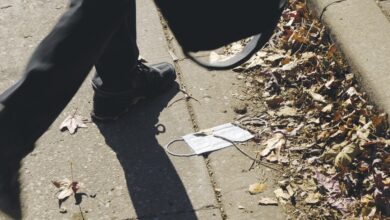Everyone Is Talking About ‘Belonging,’ but What Does It Really Mean?

So is “belonging” just the latest buzzword in higher ed?
Yes, and no.
In many ways, the growing infrastructure to support belonging is just an extension of efforts to be more welcoming of students — and faculty and staff members — whom the founders of most colleges did not have in mind. At a time when diversity and equity are under fire in many quarters, belonging — a universal human need — may be less controversial, less political.
But the focus on belonging also represents an important shift: In the past, higher education has often blamed retention problems on students’ deficits. Now, as pressure grows to keep enrollments up, more administrators are asking what colleges are doing wrong when large numbers of students don’t make it to graduation. Some are latching onto a “sense of belonging” as a potential lever of change, both for student success and to improve retention of faculty and staff members. Creating that sense is not just nice to do, says Marjorie Hass, president of the Council of Independent Colleges. It’s “a strategic question” central to institutional survival.
The literature on belonging has also evolved. When Terrell L. Strayhorn published the first edition of his book, College Students’ Sense of Belonging, in 2012, there was relatively little research on the topic. “We have missed for decades the important role that relationships and feeling supported and valued, safe, and secure to be oneself at school and college played in the formula for success,” Strayhorn says. “That’s what belonging is.”
The stakes are high: Research shows that college students who feel that they belong at their institutions get better grades and fare better on persistence, engagement, and mental health. Conversely, Strayhorn writes in his book, “Students who do not feel like they belong rarely stay in college.”
For all the progress in research and all the resources being invested across higher education, though, no one has perfected a blueprint for belonging. Ultimately, some say, the goal may be elusive.
While the need to belong transcends categories such as race, sexual orientation, social class, and ability status, students in underrepresented or marginalized identity groups are more likely to arrive on campus already wondering if they belong there. Gregory M. Walton, a professor of psychology at Stanford University who co-wrote an influential study on a belonging intervention, says that for those students, negative experiences that others might easily brush off, such as receiving criticism or feeling lonely, can have a more lasting impact on motivation. Those kinds of experiences can even make it more difficult “to do the hard work of learning new material,” he says.
Administrators are asking what colleges are doing wrong when large numbers of students don’t make it to graduation.
Jillian Kinzie, interim co-director of the National Survey of Student Engagement, which added questions about belonging to its annual survey in 2020, says the key is to help students connect with a group that supports what they feel is a salient part of their identity. Those could be groups based on race, religion, or sexual orientation, but also an academic interest or a sports team, for example.
The Covid-19 pandemic also elevated the urgency of tackling belonging by reinforcing the idea that students don’t go to college simply to gain knowledge but also to connect with others. Strayhorn believes some colleges are turning to the message of belonging as we come out of the pandemic — and the enrollment declines that came with it — to appeal to the growing number of students and families who are questioning whether to attend college at all. “This push for belonging is part of the persuasive apparatus of higher education to convince its customer that higher education is still a good choice,” Strayhorn says.
Traditional-age college students — who may be leaving behind friends and family members to build lifelong relationships, intellectual interests, and perhaps even a new sense of themselves — often wonder about their place in a particular community, or in the world.
A person’s sense of belonging can also change in different contexts, or over time. One student might feel at home in a psychology lab but out of place at a sorority party, for example, or may feel alone at the start of the first year in college but later come to feel at home there. Surveys typically capture only a snapshot in time. Colleges pouring resources into student belonging are aiming at a moving target.
If the feeling of not belonging is an inescapable part of life, and a context-specific and ephemeral one at that, what should colleges be aiming for?
They are still figuring it out. When Gray, who teaches a graduate course on school belonging, had his students look for the term “belonging” on university websites, they found it in many strategic plans. But they had a harder time finding measurable goals or achievements. “It’s not clear or apparent how a definition of belonging gets aligned with their indicators of success,” Gray says.
According to one critic, that lack of clarity is par for the course. Musa al-Gharbi, a Ph.D. candidate in sociology at Columbia University and a research fellow at the Heterodox Academy, says the diversity, equity, and inclusion administrators in higher education already do “too many things and none of them well enough.” He worries that expanding the mission of an already “ill-defined administrative apparatus” to include belonging will waste more money.
Still, some colleges are forging ahead by building on what they do know. Syracuse University decided to hire a director of inclusion and belonging after the theme of belonging appeared repeatedly in conversations with students, faculty, and staff, says Mary Grace Almandrez, vice president for diversity and inclusion. Students, for example, asked administrators for more resources to help create a sense of community on campus, while faculty members talked about the need to change the organizational culture to be more inclusive and welcoming in order to complement efforts to not just recruit but retain diverse workers.
“Oftentimes when we recruit diverse employees or diverse students, we rely on the richness of their diverse perspectives to educate us,” Almandrez says. “But we, as an institution, have to also transform and change and think about our structures and our policies and procedures.”

LJ Davids for The Chronicle
The first step is trying to ensure that no one feels actively excluded. That can mean, for example, encouraging instructors to learn how to pronounce students’ names correctly. Ensuring that transgender or nonbinary students’ chosen names are the ones used in the college’s systems and by professors. Making sure students’ basic needs are met so they can focus on learning. Accommodating disabilities and uncovering the hidden curriculum — those unspoken expectations that students whose parents have degrees don’t need to learn — for those who don’t know to ask.
“When a student who’s living with a disability can’t access a room or a building or attend an event with the guest speaker because the room’s not fitted for those who live with a wheelchair or there’s no sound system in mind for those with auditory disabilities [or] there’s no interpreter — that’s how you say to people, ‘You don’t belong here because we’re not even thinking of you,’” Strayhorn says.
Improving belonging might also look like strengthening discrimination and harassment policies, investigating tenure and promotion policies for faculty members, or examining merit raises for women or people of color.
Experts suggest mining data to determine potential areas for improvement and talking to students to learn more about their experiences. One place to start, says Kinzie, from the National Survey of Student Engagement, is to drill down into the social-identity groups on campus to see which have a low sense of belonging and talk to students — whether they are students of particular races, students in certain majors, part-time students, or students caring for dependents, for example — to understand the stories behind the numbers.
Another strategy is to look at engagement activities that are associated with a high sense of belonging — such as helping students develop relationships with people whom they can go to when they feel disconnected, activities that encourage interactions among students from different backgrounds, and events about important social, economic, or political issues — and strive to ensure that more students can have those kinds of experiences.
Kinzie says improving students’ sense of belonging is “totally within the power of institutions to influence.” Higher-quality relationships with faculty members, administrators, and their peers are positively associated with a sense of belonging, which means colleges should focus on helping students find people they can relate to.
The seminars, which meet twice a week, are intended to help students find their footing at the university. Together, students explore the resources available to them, start building relationships, and generally learn how to be college students together.
Perez’s class tends to draw students who are undocumented or have family members who are. Many grew up feeling ashamed of their status and feeling afraid to talk about information that might be used against them or their family members.
Perez tries to create a safe environment for students to explore and embrace their identities, and to empower them to fight for their rights. Teaching the class, Perez says, has made her realize that, much of the time, higher education can be very transactional. It’s not enough, she says, for professors to care about students’ academic success; they need to be more in tune with and sensitive to students’ needs and their lives outside of class. “It’s so important to humanize the student experience in order for that sense of belonging to be cultivated,” Perez says.
Estefania Campos, who took Perez’s class in 2018, says it helped give her the space to think about her identity as a beneficiary of the Deferred Action for Childhood Arrivals program, an Obama-era initiative that has helped prevent thousands of undocumented students and other young people from being deported. She knew many students who went to class and then went home, eventually receiving their degrees but never really finding their place or a direction. Campos says her class with Perez — and their continuing relationship — changed the course of her career and the way she thinks about the world.
“It starts with having those tough conversations, sharing what your purpose is and who your identity is,” Campos says. “I think that’s the best way to find your community.”
When a student with a disability can’t “attend an event with the guest speaker because the room’s not fitted for those who live with a wheelchair — that’s how you say to people, ‘You don’t belong here.’”
When administrators at Southern Illinois University at Edwardsville learned that Black students, who make up about 14 percent of its undergraduates, graduated at lower rates than did other demographic groups, they resolved to tackle the problem. Last year a longitudinal study uncovered a bright spot and possible strategy: About 42 percent of Black students who took a course in African American literature aimed at first-year students later graduated, compared with about 29 percent of Black students who didn’t take the class. (While any first-year student can enroll in the class, most students who take the class are Black.)
So the university expanded the course, now known as “The Black Scholar Experience,” from 50 students in 2021 to about 310 students last fall. The class covers Black writers and artists but also topics such as why Black students struggle to graduate, how to manage stress and time in college, and barriers faced by Black women at the university. “We’re really trying to support not just their transition to the institution, but very clearly from the very beginning, say you belong here, you have a community here,” says Jessica C. Harris, vice chancellor for antiracism, diversity, equity, and inclusion.
Howard Rambsy, a professor of literature, has taught the class since 2004. He says students often tell him that they feel a sense of connectedness there, that they feel seen. “They felt like they were in a space in this class where they … didn’t have to overexplain certain kinds of things,” Rambsy says.
And opportunities for students to interact with one another as peers across cultures are important, says Paulette Granberry Russell, president of the National Association of Diversity Officers in Higher Education. Research shows that those types of opportunities can buffer against discrimination and bias. “There’s a greater sense of well-being that can be created as a result of those students’ understanding those differences, engaging across differences,” Russell says.
Many experts say it’s important to both build bridges and provide affirmation of students’ identities. But al-Gharbi, of Columbia, says college administrators often make incorrect assumptions about why underrepresented students don’t feel a sense of belonging. He says colleges often focus on “niche, idiosyncratic values,” identity, and pursuing social justice in ways that are “actually alien and alienating to a number of people from less-traditional backgrounds.”
While there’s no such thing as a magic bullet for belonging, Walton’s 2011 study may come close. It found that Black students who reflected on the idea that students of all backgrounds can struggle initially with the transition to college improved their academic performance over the next three years, cutting the achievement gap in half. An intervention based on the research is available to colleges through the College Transition Collaborative and the Project for Education Research That Scales.
Based on his research, Walton says that, rather than telling students that they belong, colleges should send the message that it’s normal for all students to struggle with the transition to college, and that things can get better with time. That message can be conveyed by top-level administrators, by professors in classes, and even in residential activities.
But while that initial message can help, it can go only so far, Walton says. If specific groups of students who receive that message later feel alienated on campus, colleges need to do the hard work necessary to resolve the underlying issues, by listening to students to learn where the trouble is. “If you’re in a space where, for whatever reason, people in your group don’t come to belong,” Walton says, no amount of messaging is going to make a difference: You need to create spaces of belonging.
Walton cites the living-learning communities at Michigan State University, which allow students who share interests in academic areas or multicultural living experiences to live together and attend some of the same classes, as an example of the structural changes some institutions are making.
Maybe there’s no guarantee. “We can’t make you feel a sense of belonging,” Strayhorn says. “But we can create the conditions where the likelihood that you will feel a sense of belonging are greatest.”
Source link







